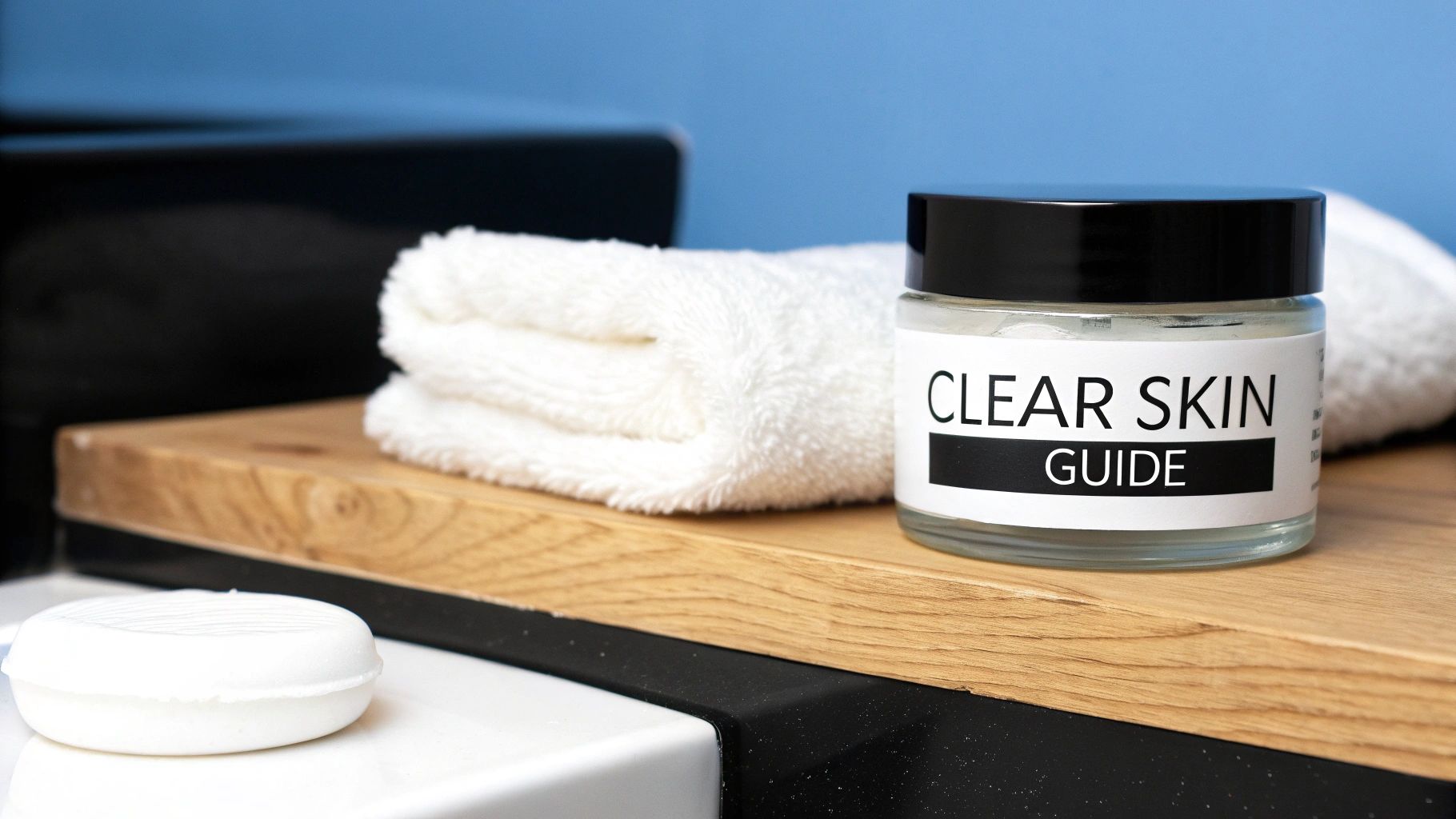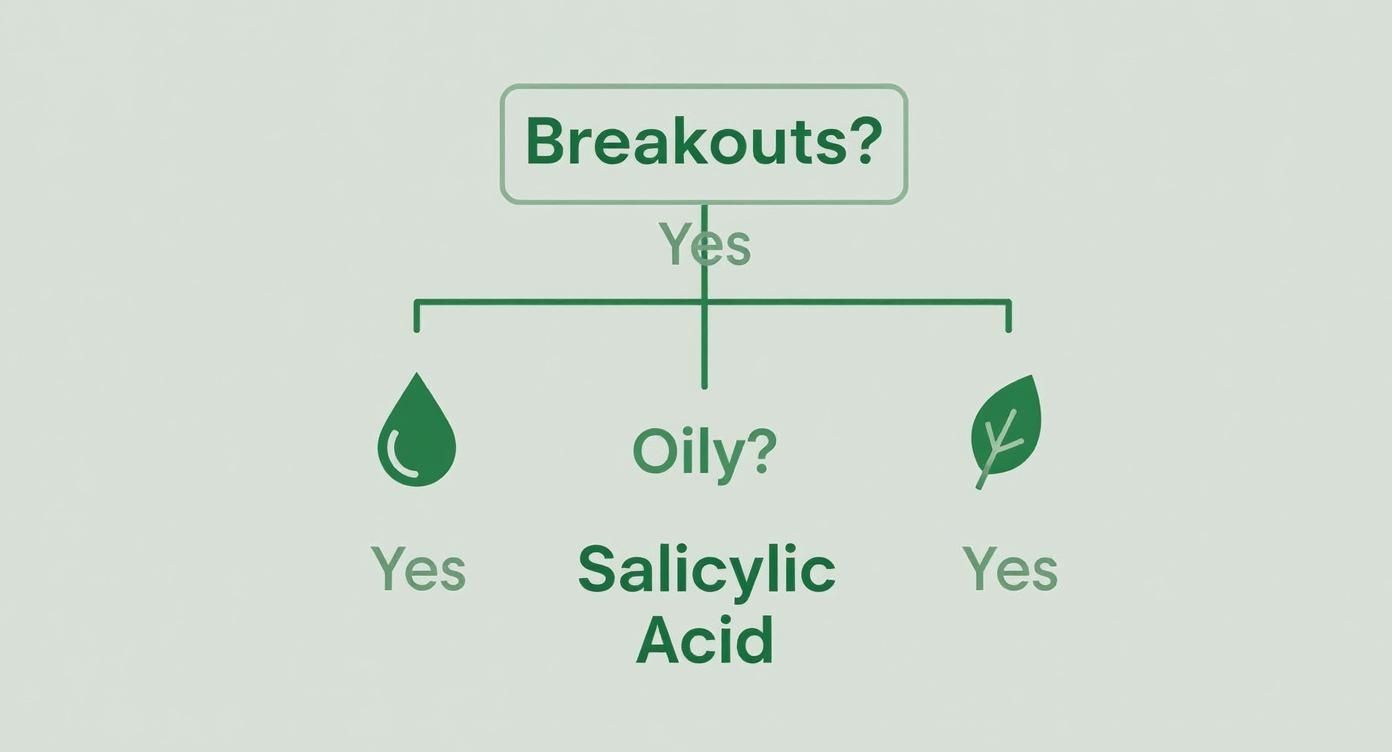Jan Elvis
11.11.2025

Jan Elvis
11.11.2025
If you've ever dealt with stubborn breakouts or that annoying bumpy texture that just won't go away, you’ve probably come across salicylic acid. But a salicylic acid face cream isn't just another spot treatment or cleanser. It’s a smarter way to work this powerhouse ingredient into your daily routine, combining its deep-cleaning abilities with the hydration your skin needs.

Unlike a lot of skincare ingredients that are here today, gone tomorrow, salicylic acid is a time-tested staple recommended by dermatologists for a reason. It doesn't just treat the pimple you see today; it gets to the root of the problem to prevent the ones you'd see tomorrow.
The secret to its success is simple: it's oil-soluble. Salicylic acid is a Beta Hydroxy Acid (BHA), which means it can cut through the oil clogging up your pores. Think about trying to clean a greasy pan with only water—it just smears the grease around. Salicylic acid is the dish soap in this scenario; it breaks down the oil and washes it away.
Because it can dissolve in oil, it sinks deep into your pores, past the sebum (your skin’s natural oil), and gets to work. Down there, it breaks up the gunk—a sticky mix of dead skin cells and oil—that leads to blackheads, whiteheads, and full-blown pimples.
A regular face wash cleans the surface. A salicylic acid face cream gets inside, acting like a key to unlock clogged pores that other products can't reach.
While it's legendary for clearing breakouts, the benefits don't stop there. The gentle exfoliating action of a good salicylic acid cream helps speed up your skin's natural renewal process, encouraging it to shed that top layer of dull, dead cells.
When that happens, you reveal the fresher, brighter skin waiting just beneath the surface. Stick with it, and you'll see some serious improvements in your overall complexion.
You can realistically expect to see:
This guide will break down everything you need to know, from the science to how to actually use it without irritating your skin. By the time we're done, you'll be able to use this ingredient like a pro to get the clear skin you're after.
To really get how a salicylic acid face cream works, you need to stop thinking of it like a simple face wash. It's much more like a specialized deep-cleaning crew for your skin. Its biggest strength lies in one key property: it’s oil-soluble. This might not sound like a big deal, but it's a total game-changer for anyone struggling with clogged pores and breakouts.
Most other skincare acids are water-soluble, meaning they can’t get past the natural oils on your skin. Think of your pores as tiny tunnels clogged with a stubborn mix of oil (sebum) and dead skin cells. Water-based ingredients just slide right over the top. Salicylic acid, on the other hand, cuts right through that oil, getting deep inside the pore to break up the clog from the inside out.
This is exactly why it's so good at tackling blackheads and whiteheads, which are really just pores blocked by that gunk.
Salicylic acid is a true multitasker. It doesn’t just do one thing; it attacks blemishes from three different angles to get your skin looking its best. Once you understand these, you'll see why it's a must-have for clear skin.
Here's what it's doing behind the scenes:
This triple-threat approach means it’s not only clearing up the spots you have now but also working to keep your skin clear for the long haul.
So, what actually happens when you put the cream on your face? Let's trace its path from application to results.
Salicylic acid is like a plumber for your pores. It doesn’t just wipe the surface clean; it goes deep to systematically clear out the gunk causing the blockage, ensuring everything flows smoothly.
While salicylic acid is a powerhouse, it's also smart to think about other wellness habits that support healthy skin. For instance, things like exploring the infrared sauna skin benefits can be a great complementary step for boosting collagen and helping with acne.
When you pair targeted skincare with a holistic approach, you’re creating a much more powerful strategy for achieving the best skin of your life.
Diving into the world of skincare, especially with active ingredients, can feel a bit overwhelming. When you're standing in the aisle looking for a salicylic acid face cream, the sheer number of options can be dizzying. But you can cut through the noise by zeroing in on three key things: the concentration of the acid, the formulation of the product, and the supporting ingredients that tag along.
Nailing these three factors is the difference between finding a product that works with your skin and one that works against it. It’s how you get that clear, calm complexion instead of ending up with a new round of irritation.
This handy decision tree can help you see where salicylic acid fits into the picture.

As you can see, if you're wrestling with both breakouts and oily skin, salicylic acid is pretty much your go-to for clearing things up.
That percentage on the bottle? It's the most critical piece of information you'll find. It tells you exactly how potent the cream is and what it's meant to accomplish. For anything you can buy over the counter, you'll typically see concentrations ranging from 0.5% to 2%.
A good way to think about these percentages is like different intensity levels at the gym:
When in doubt, start low and go slow. See how your skin handles a lower concentration before you decide to level up to something more powerful.
Choosing the right strength is the first step to making sure the product is effective but not overly harsh for your skin. This table breaks down which concentration is best for different needs.
| Concentration | Best For | Primary Use Case |
|---|---|---|
| 0.5% - 1.0% | Sensitive skin, beginners, or daily use | Gentle exfoliation, preventing minor breakouts, skin maintenance. |
| 1.0% - 2.0% | Oily, combination, and acne-prone skin | Treating active acne, clearing blackheads, controlling excess oil. |
This quick guide helps you match the product's power to your skin's problems, ensuring you get the results you want without any unnecessary side effects.
Beyond the percentage, the actual feel of the product—its texture and consistency—is a huge deal. The right formulation acts as the perfect delivery vehicle for the salicylic acid, making sure it gets where it needs to go while keeping your skin type happy.
Picking the wrong one can backfire, either leaving your face a greasy mess or making it feel tight and stripped. The goal is always to find a happy medium that complements your skin's natural state.
A product's formulation is the delivery system for its active ingredients. A great active in the wrong system for your skin type won't deliver the results you're looking for.
Here’s a quick rundown of the most common textures you’ll find:
Finally, the best salicylic acid face creams don't rely on the BHA alone to get the job done. Top-tier products are packed with other powerhouse ingredients that either boost the acid's benefits or help counteract potential side effects like dryness.
You don't need to be a chemist to read the label—just keep an eye out for a few key players. These "partner" ingredients are what elevate a product from good to great.
Look for these on the ingredient list:
By keeping an eye on the concentration, formulation, and supporting ingredients, you'll be able to confidently pick a salicylic acid face cream that’s just right for you.
Bringing a powerful ingredient like a salicylic acid face cream into your routine is a total game-changer, but the secret to success is strategy, not aggression. Think of it like starting a new workout program. You wouldn't walk in and immediately try to lift the heaviest weights, right? You’d start slow and let your body adapt. Your skin needs that same respect.
The golden rule here is to start slow and build momentum. Kick things off by applying your cream just two or three times a week. This gives your skin a chance to get familiar with the ingredient without freaking out. It’s a simple move that helps you sidestep the redness and peeling that often happens when you go too hard, too fast.
This gradual introduction is everything. It lets you keep an eye on how your skin is responding and figure out the perfect frequency for clear, smooth results without any unnecessary drama.
Knowing when to apply your salicylic acid cream is just as important as how often. The order you apply your products makes a huge difference in how well they work. For a full breakdown, our guide on the correct skin care order of application lays it all out.
As a rule of thumb, any salicylic acid product goes on clean skin, before you layer on thicker stuff like heavy moisturizers or oils.
A Sample Morning Routine:
A Sample Evening Routine:
Your skincare routine isn't a race. It's about being consistent and smart. Applying your salicylic acid cream after cleansing but before moisturizing ensures it can actually get into your pores without being blocked.
To get the results you want from salicylic acid, there are two rules you absolutely cannot break. Ignoring them can lead to irritation, sun damage, and a trashed skin barrier—basically setting you back to square one.
First, you must wear sunscreen every single day. Salicylic acid is an exfoliant, meaning it helps you shed dead skin cells to reveal fresh, new skin underneath. That new skin is much more sensitive to the sun's damaging UV rays. A broad-spectrum SPF 30 or higher every morning is your best defense against sun damage and dark spots.
Second, pay attention to the other active ingredients you're using. Trying to mix salicylic acid with other heavy-hitters like retinol or glycolic acid in the same routine can be way too much for your skin. It's a fast track to over-exfoliation, which looks like redness, sensitivity, and peeling. If you want to use both, alternate them—maybe salicylic acid in the morning and retinol at night, or use them on totally different days. This way, you get the benefits of both without overwhelming your skin.
The fact that salicylic acid is everywhere isn't just a trend; it’s a cornerstone of a massive global industry. The global salicylic acid market was valued at around $511.34 million in 2025 and is on track to hit $863.45 million by 2035. A huge chunk of that is driven by products designed to fight acne and inflammation, which just goes to show how effective this stuff really is. You can dig into more insights on this growing market over at Future Market Insights.

Getting killer results from your salicylic acid face cream is as much about dodging the wrong moves as it is about making the right ones. Even the best products can turn on you if you're not careful. Let's walk through a few common blunders so you can keep your skin on the right track.
The biggest mistake? Going too hard, too fast. It's a classic case of thinking that if a little bit is good, a lot must be better. With active ingredients like this, that logic will lead you straight to irritated, angry skin.
Using your salicylic acid cream too often or piling it on with other harsh exfoliants is a recipe for disaster. It can literally strip away your skin's natural protective barrier—think of it as taking down the security system for your face. When that barrier is compromised, irritants waltz right in, and essential moisture escapes.
What you're left with is redness, peeling, and a stinging sensation. Pretty much the exact opposite of what you were going for, right? To avoid this, always follow the "start slow" rule. For a full breakdown on this, check out our guide on how to exfoliate your face properly to really nail the fundamentals.
And it's no wonder this is a common issue. Salicylic acid is everywhere. In 2023, the global market for these creams was valued at roughly $1.5 billion and is expected to hit $2.8 billion by 2032. That massive demand shows how many people are looking for clear skin, but it also means more guys need to learn how to use these products correctly. You can dig into more market insights over at DataIntelo if you're curious.
Another classic error is expecting an overnight miracle. Look, salicylic acid is a powerhouse, but it's playing the long game. It has to work its way deep into your pores to break down all that gunk and prevent new clogs from forming. That process just doesn't happen in a day.
Expecting instant results from salicylic acid is like planting a seed and expecting a full-grown tree the next morning. Lasting change requires consistent care over several weeks.
You might notice some redness go down within a few days, but the real, noticeable changes in texture and breakouts usually take a solid 4-6 weeks of consistent use. You have to stick with it. Patience is a key ingredient here.
Finally, burn these two non-negotiable rules into your brain:
By sidestepping these common slip-ups, you're setting yourself up for a smooth, irritation-free journey to the clear skin you're after.
Jumping into a new skincare routine, especially with a heavy-hitter like salicylic acid, always comes with a few questions. That's completely normal. Getting a handle on the specifics is the best way to feel confident and see real results. Let's clear up some of the most common things guys wonder about when they start using a salicylic acid face cream.
Probably the first thing on your mind is: how long until I see a change? You're putting in the work, and you want to know when the payoff is coming.
You might see some of the angry redness from a big pimple calm down in just a couple of days, which is a great early win. But the real magic of salicylic acid happens on a deeper level, and that takes a little more time. It's working its way into your pores to dissolve the gunk that's already there and stop new clogs from forming.
For those bigger, more noticeable changes—like smoother overall skin texture and way fewer breakouts—give it about 4-6 weeks of consistent use. This isn't a one-and-done spot treatment; it's about playing the long game.
Think of it like deep cleaning your garage. It takes a while to sort through all the old junk, but once it's clear, it's much easier to keep it organized and clean from then on. Stick with it.
This is a smart question, and the answer isn't a simple yes or no. It really boils down to your skin's personality and the concentration of the product you've got. If you're using a cream with a lower percentage of salicylic acid, say 0.5% to 1%, and your skin isn't the sensitive type, you can probably use it daily without any trouble.
But if you're new to the game or using a more potent 2% formula, it’s best to ease into it. Start by applying it just 2-3 times a week. See how your skin reacts. If there’s no excessive dryness, flaking, or irritation after a week or two, you can slowly start using it more often.
Knowing what not to mix with your salicylic acid cream is just as important as knowing how to use it. If you throw too many powerful ingredients at your face at once, you risk damaging your skin's natural barrier, leaving it red and angry.
To keep your skin in the clear, avoid layering these at the same time:
Keeping these pointers in mind will help you get the most out of your routine without any setbacks.
Ready to take control and get skin you can feel great about? Main Character has the straightforward, effective products you need to build a routine that actually works.